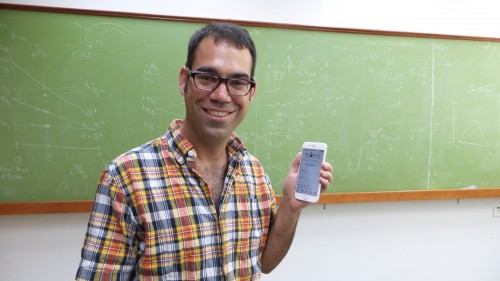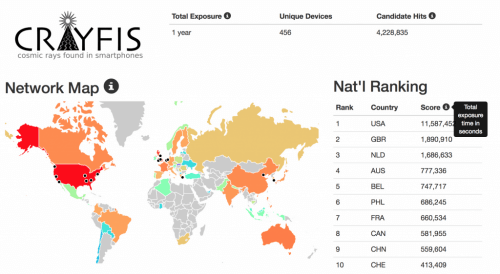Prof. Kyle Cramer from New York University developed an application Crayfis uses the camera and GPS data to locate energetic particles of cosmic rays. A global deployment of phones running the app will create the world's largest detector of cosmic rays and help scientists understand its origin. Kramer was interviewed by the Hedaan website during his visit to Israel this week for a scientific conference

The term "Citizen Scientist" has gained momentum in recent years, but its content has existed perhaps since the beginning of the Internet - scientific applications that use the desktop computers of home users or even offices, whose utility is not high anyway to analyze the radio signals received from space in order to locate them Perhaps, signals broadcast by intelligent beings.
Since then the field has developed and today it is possible to provide computing power to search for new medicines and in recent years citizens have also started to be active partners in the scientific process - for example in mapping the Earth, or locating formations on Mars from photographs of the spacecrafts that surround it and which requires a human eye to distinguish the small details. There are also quite a few mobile applications that make it possible to do science - most of them, by the way, in the analysis of so-called big data.
But there was no such thing yet - the phone itself is used as a detector of high-energy and rare cosmic waves.
Prof. Kyle Kramer from the Department of Physics at New York University, who these days works at CERN together with Prof. Elam Gross from the Weizmann Institute, who came this week to a scientific conference as a guest of Prof. Gross, together with two of his colleagues developed an application for cell phones that uses a sensor The light of the device's camera, with the knowledge of its location and at the exact time to locate enormous cosmic rays.
Cosmic radiation was discovered in 1912 by the astronomer Victor Hess, who also received the Nobel Prize in Physics for his discovery in 1936. This is radiation that falls on us from space, but we do not receive it in its full force because these particles usually hit atoms and molecules in the upper atmosphere, turning into a rain of energetic particles Much lower than the energy of the original particle, some of which reach the surface of the earth.
About a year ago, scientists published findings based on data from the Fermi Gamma Ray Telescope, which indicate that the origin of the low-energy cosmic rays is supernovae. However, the source of the particularly energetic particles remains a mystery.
"The first particle of this type was discovered in 1990 and earned the nickname "Oh-my-God Particle - the particle of admiration, if you will, as a paraphrase on the Higgs boson called the "God particle". Kramer says in an interview with the science website.

"The most energetic cosmic rays have an energy equal to the impact of a baseball hitting the nucleus of one atom at a speed of 100 km/h. This is much higher energy than that detected in the detectors of the Large Hadron Collider (LHC) in Sarn, however, the Pierre Oger Observatory in the Argentine desert contains water tanks with detectors inside them, whose job it is to locate the effect of cosmic rays on the water, and thus retrieve their properties. This is a site with an area of 3,600 square kilometers - the size of a small country like Luxembourg. The average by the way is once per hundred years per square meter. "
The question still remains open as to what might be responsible for accelerating the particles to such high energies. "It must be a nearby source, because otherwise they would lose energy and slow down as a result of the collision with molecules scattered in the universe, however, no source that can be linked to a specific particle has been found to date.
To decipher the secrets of these mysterious cosmic rays it would be necessary to run such an experiment for a long period of time, or an array of sensors spread over a much larger land area. The arrays that exist today that contain efficient devices like a register cannot grow significantly without increasing their cost. And therefore thinking outside the box was necessary.
It turns out that it is possible at almost zero cost to turn the entire earth into a telescope for detecting cosmic rays. The detectors are in the pocket of each of us - the cell phones.
"Cell phones are good candidates to become a global detector of cosmic rays. Phones these days are high-tech gadgets. The camera sensor is very similar to the pixel detectors of the Atlas and CMS experiments in Sarn, and their sensing range also includes the field of the same radiation meter created after the particle collided with the atmosphere.
In addition, most phones are equipped with a GPS detector that knows where the user is, WIFI connections to the Internet and significant processing capacity, and perhaps most importantly - billions of phones are already in use.
In October 2014, a small team led by Daniel Whitson from the University of California, Irvine, and Michael Mohleran from the University of California, Davis, published an article with a proposal to operate a global network of smart phones to detect cosmic radiation. The article also collects laboratory tests of cell phone cameras and simulations of high-energy cosmic ray meters.
The findings indicate that if we have an array spread over an area of a thousand square kilometers, each of which will have a thousand phones, the exposure time will be equivalent to that of the Pierre Auger observatory. The article gained immediate attention. Following him, the Crayfis application was developed, which was joined by over 50,000 people from around the world. This is despite the fact that Crayfis versions for IOS and Android are in beta testing. I joined the project and assisted in the development of the IOS application and the website.
All that is needed is to connect the phone to the charger (otherwise turning on the camera eats up the battery), place it on the table with the camera on the side facing the table and leave it in that position all night. If the phone believes it has been hit by cosmic radiation it will upload the data to the Crayfis server. We will then look for which other phones reported the impact at the same time, indicating that this is not background noise but a real meter of cosmic radiation. Each user receives a report on the number of particles he discovered and their strength, and a kind of competition takes place between the users.
"Now we are working to improve the interface to make it more friendly and enjoyable, so that the citizen scientists can contribute to scientific knowledge, and we can do great science, without paying for the establishment of sensors worth hundreds of billions of dollars, in a global deployment. Without a doubt it will be the biggest detector in the world." Kramer concludes.
For Prof. Kramer's blog article

2 תגובות
The direction of the camera lens is not important. I guess the goal is to darken the sensor to lower the level of "noise" from visible light. The cosmic radiation will penetrate the body of the device without any problem and will directly affect the CCD. By the way, cosmic radiation also causes disruptions in memory components and other electronic components. Most of the time the effect is extremely negligible, but in critical systems that cannot tolerate memory write/fetch errors, the issue is definitely taken into account. In fact, it is possible that they could develop a solution similar to the one presented in the article using other components that exist in the cell phone and not necessarily in the camera. Its advantage is probably the size of the sensor. I use a digital camera to check for the presence of X-rays - when the lens is covered you see colored noise in the image. Nice and useful patent.
Do not understand.
The eye of the camera is pointed towards the table, will the index come from the direction of the ground?! But it's not neutrino-particles!